
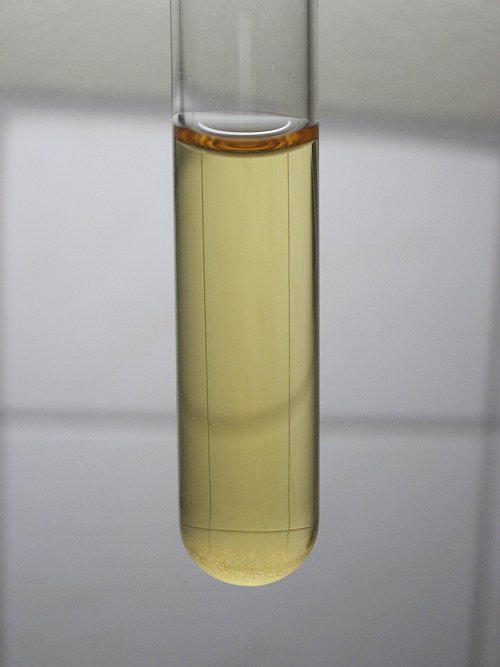

Aqueous solutions and precipitates of iron
In aqueous solutions, iron exists in the +1, +2, +3, +4, and +6 oxidation states. Iron in the +2 and +3 oxidation states exists in aqueous solution as plain aqua ions Fe2+(aq), which is stable in acidic and neutral solutions, and Fe3+(aq), which is stable only in strongly acidic solutions. Iron in the +6 oxidation state exists as the ferrate ion FeO42-(aq). The latter only is stable in strongly alkaline environments.
A very special oxidation state for iron is +1. This exists in aqueous solution as the nitrosyl complex [Fe(NO)(H2O)5]2+. Another very special and relatively unknown oxidation state is +4. This can be prepared when hydrogen peroxide is added to a near neutral or very slightly acidic solution of an iron (II) salt. Such a solution, sometimes called Fenton's reagent, contains the ion [Fe(H2O)4(OH)2]2+.
The +2 oxidation state is mildly reducing. Solutions of this are stable with respect to aerial oxidation, but when it is precipitated as hydroxide, then it suddenly becomes very sensitive to aerial oxidation. The +3 oxidation state is mildly oxidizing when in solution as iron (III) species. Oxidation state +6 is very strongly oxidizing in strongly alkaline solution. When the pH is lowered, then the oxidizing power becomes so large, that the ion cannot exist anymore in solution.
![]()
Oxidation state +1
In this oxidation state, iron is only stable when coordinated to a nitrosyl ion (NO+). Plain aqueous iron (I) is not possible, but the nitrosyl ion stabilizes this strange oxidation state for iron, such that the ion can exist in water. Preparation of iron in this oxidation state is remarkably simple. It can be prepared by adding an acidic solution of a nitrite to a solution, containing aqueous iron (II) ions. The nitrite disproportionates in the acidic medium, forming NO and HNO3. The NO coordinates to iron (II) and an electron shift occurs, causing the iron to go to oxidation state +1 and the NO to change into a nitrosyl ligand NO+. The resulting ion is [Fe(NO)(H2O)5]2+. The left picture below shows an acidified solution of an iron (II) salt, to which a very tiny amount, just a few crystals, of solid sodium nitrite is added. This results in immediate formation of the brown iron (I) complex. When all of the nitrite is dissolved, then the liquid has become dark brown, almost black. The right picture shows a fairly strong dilution of the liquid, such that the color becomes visible more easily.
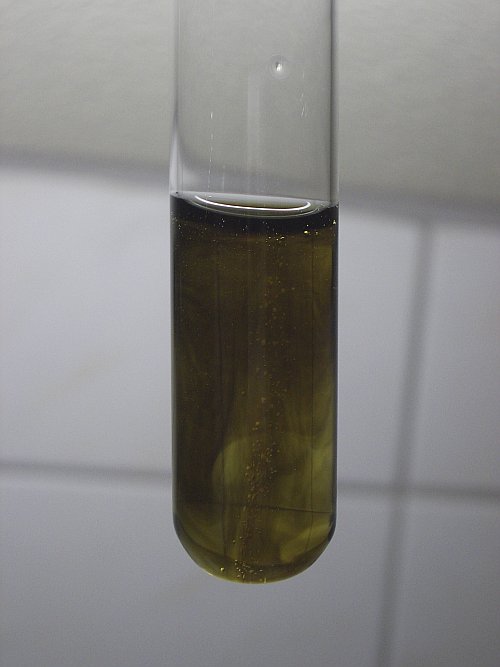

This brown complex also is used in the so-called brown ring reaction for detection of nitrate ions. This test works by adding some ferrous salt to the solution to be tested. The solution, containing aqueous iron (II) and (possibly) nitrate ions, is poured on concentrated sulphuric acid very carefully. If nitrate is present, then a brown ring is formed at the fuzzy interface between the H2SO4-layer and the aqueous layer. At the strongly acidic conditions in this interface-layer, the nitrate ions oxidize ferrous ions, forming NO and ferric ions. The NO in turn reacts with excess ferrous ions, forming the deep brown nitrosyl/iron(I) complex.
The brown complex is not very stable. Immediately after preparation of the complex, the color slowly fades. After several minutes, the color already is less intense.
Oxidation state +2
This is a mildly reducing oxidation state in acidic and neutral solutions, and a strongly reducing oxidation state, when precipitated as hydroxide. The hydroxide, however, is not capable of reducing water with evolution of hydrogen gas (as opposed to the hydroxide of titanium (III) and vanadium (II)).
A solution of an iron (II) salt is very pale green. Even at fairly high concentration of the iron, the solution looks almost colorless. Only, when the solution is placed in front of a white piece of paper, one can see the very light green color. The two pictures below show a solution with an iron content of approximately 2% mass percents of iron.
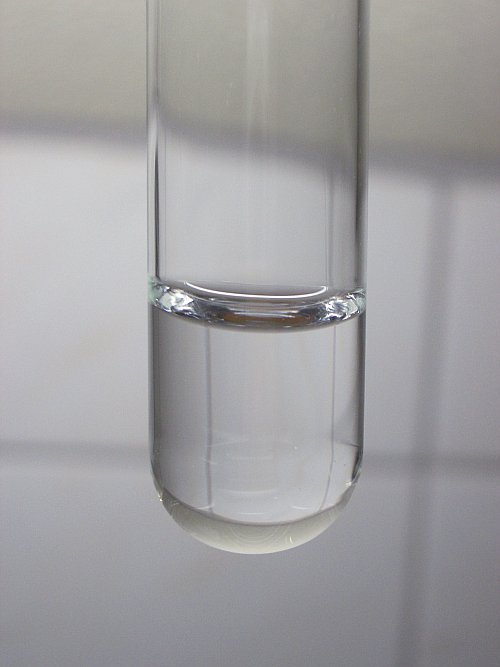
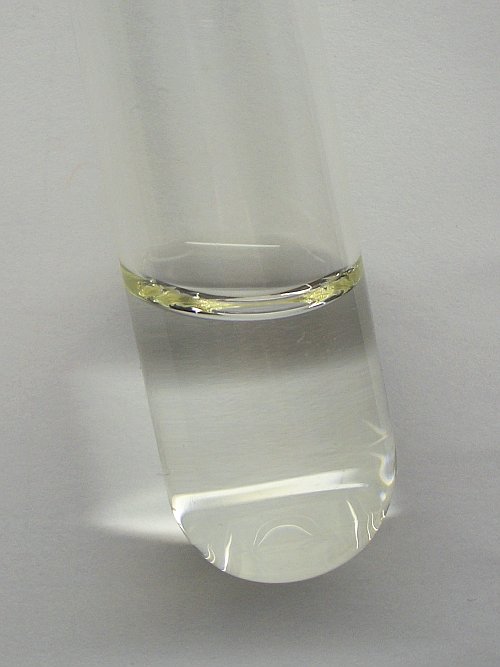
When a solution of sodium hydroxide is added to the very light green solution, then a light green, almost white precipitate of ferrous hydroxide, Fe(OH)2 is formed. This precipitate is oxidized by oxygen from the air almost immediately. The left picture shows a freshly prepared precipitate of ferrous hydroxide, with the material at the surface already oxidized to a brown compound. The middle picture and right picture show what happens with the precipitate, when it is shaken for a few seconds with air-contact. The precipitate first darkens to a dark green color, but when it is allowed to be in contact with air for a longer time, then it finally becomes brown.

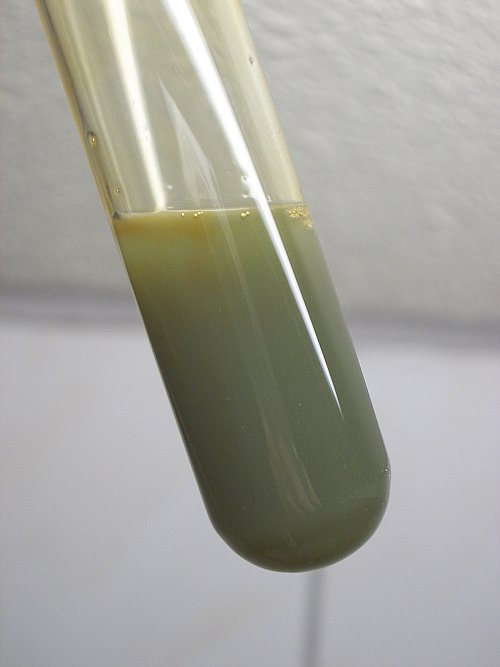
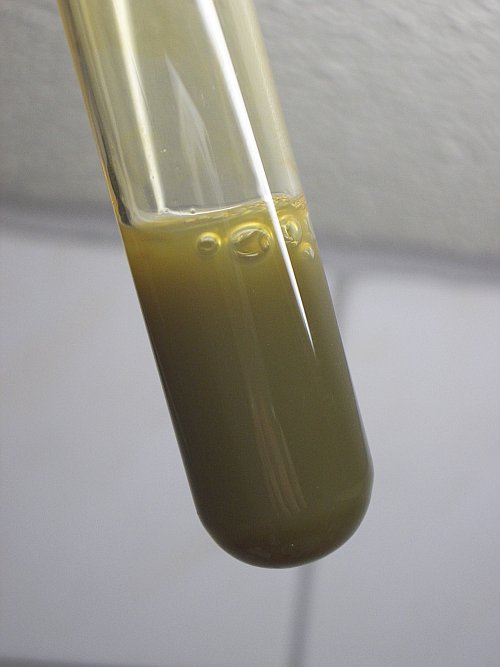
The glass, at which the light green precipitate of ferrous hydroxide is sticking becomes brown immediately. This is due to oxidation of the iron to the +3 oxidation state. The picture below nicely shows this effect.
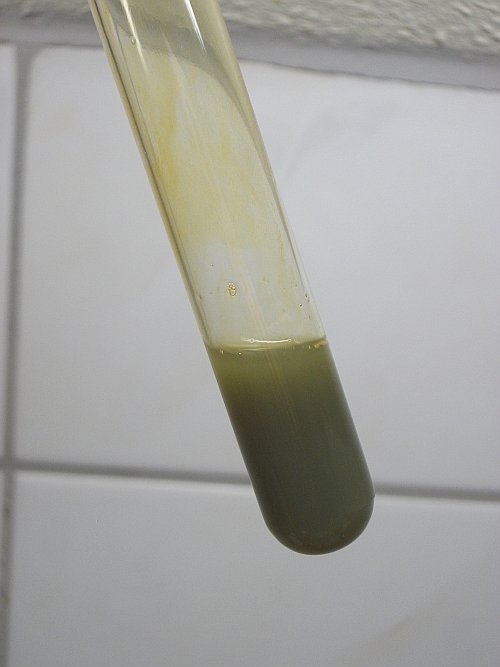
![]()
Oxidation state +3
Iron in the +3 oxidation frequently is said to have a brown/yellow color in aqueous solutions, but this is not correct. When an iron (III) salt is dissolved in water, then indeed a brown/yellow solution is obtained, but this color is due to formation of hydrolysed iron (III) species.
Real aqueous iron (III) is almost colorless. Below, two pictures are shown. The left picture shows a solution, containing iron (III) in dilute nitric acid (concentration of HNO3 equals 2 mol/l). The right picture shows a solution with a similar concentration of iron (III), but now in distilled water. The right test tube also shows some precipitate at the bottom of the test tube, this is due to hydrolysis, as explained below in more detail.
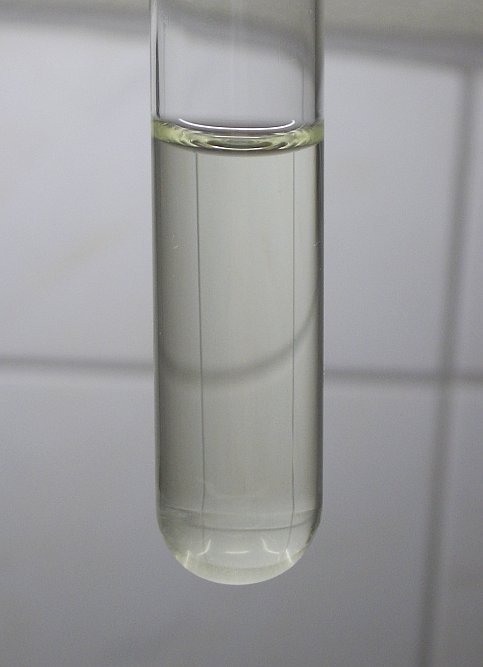

Iron (III) is very prone to hydrolysis. When an iron (III) salt is dissolved in water, then the following reaction occurs.
Fe(H2O)63+(aq) → Fe(OH)(H2O)52+(aq) + H+(aq)
The hexa-aqua ion looses a proton and changes to a hydroxo-species. The solution becomes acidic. The hydroxo-species of iron (III) has a yellow/brown color and this is what is observed.
In reality, the reaction between iron (III) and water is even more complex. More than one water-ligand can loose a proton and in practice this all goes up to the formation of hydrous ferric hydroxide, which settles at the bottom as a fine precipitate. Also poly-metal cationic species are formed, with bridging OH– ligands. Complicated ions with formulas like [(H2O)4Fe(μ-OH)2Fe(H2O)4]4+ are formed in solution. The actual yellow/brown color hence is the observed color, caused by a mix of many cationic species.
Only at pH < 0 there are no ferric ion species with hydroxo groups and then the real color of aqueous iron (III) ions can be observed. Pure hydrated iron (III) salts also have a very light color, usually light brown/violet. That also demonstrates that hexa aquo iron (III) ions only have a faint color.
Another misconception, often introduced is that iron (III) ions are yellow. A very common iron (III) salt is ferric chloride hexahydrate. When a solution of this salt is prepared, then a fairly intense yellow/brown solution is obtained. This solution contains the hydroxo iron (III) species, mentioned above, but it also contains chloro-complexes of iron (III).
When an excess amount of a concentrated solution of sodium chloride or hydrochloric acid is added to the acidic solution, containing aqueous iron (III) ions, then the solution turns deep yellow. The left picture again shows the solution of iron (III) in 2 M HNO3. The right picture shows the same test tube, but now with some concentrated solution of NaCl added. The color has changed from very pale green/brown to deep yellow. This yellow color is due to the complex FeCl4–.


So, summarizing, iron (III) often is assigned a wrong color in text books, both due to formation of hydroxo-complexes and to formation of chloro-complexes in aqueous solution.
When iron (III) nitrate is used for this sequence, then the fact that iron (III) is almost colorless can even better be demonstrated. Below, a fairly concentrated and freshly prepared solution of iron (III) nitrate is shown in the left picture. This solution is remarkably clear and looks almost orange. Probably this is due to the fact that the iron (III) nitrate itself already is quite acidic (it has an acrid smell of nitric acid). The middle picture shows the result of adding a small amount of dilute nitric acid (2 mol/l) and this shows a colorless liquid. The right picture shows the result of adding a small amount of dilute hydrochloric acid (10% HCl by weight) to the colorless liquid of the middle picture.
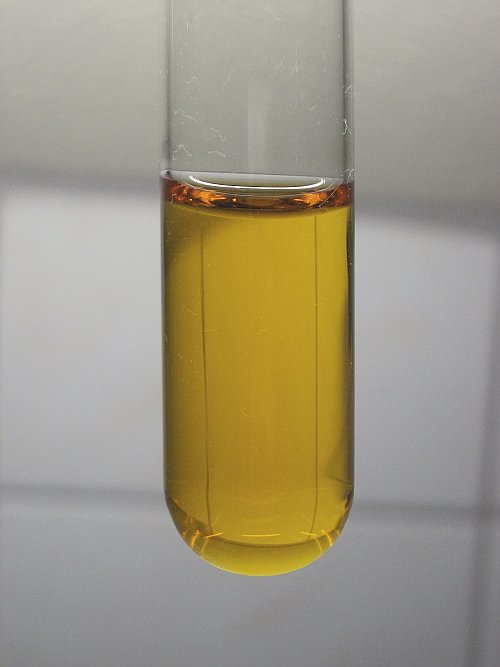
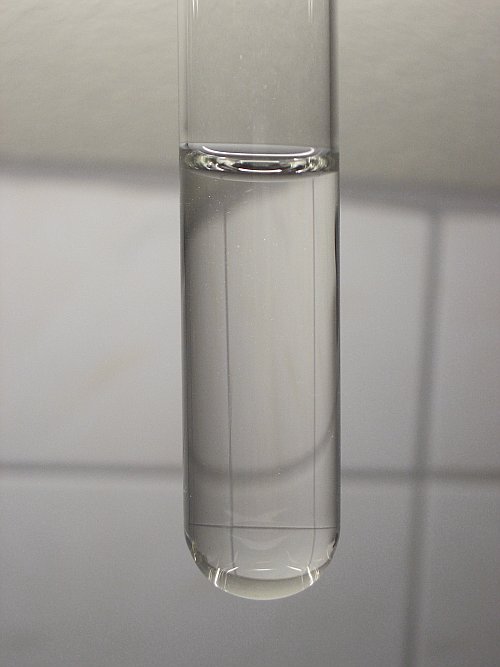
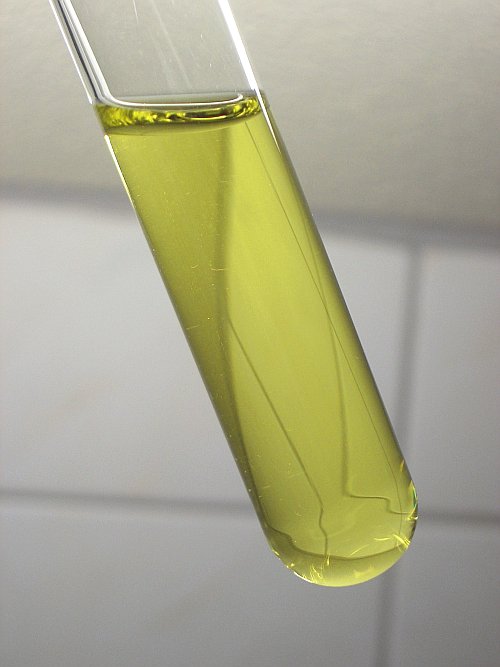
In alkaline solution, the situation becomes much more simple. Iron (III) and all of its hydroxo- and chloro-complexes forms hydrous Fe(OH)3 with a red/brown color. A picture of this precipitate is shown below.
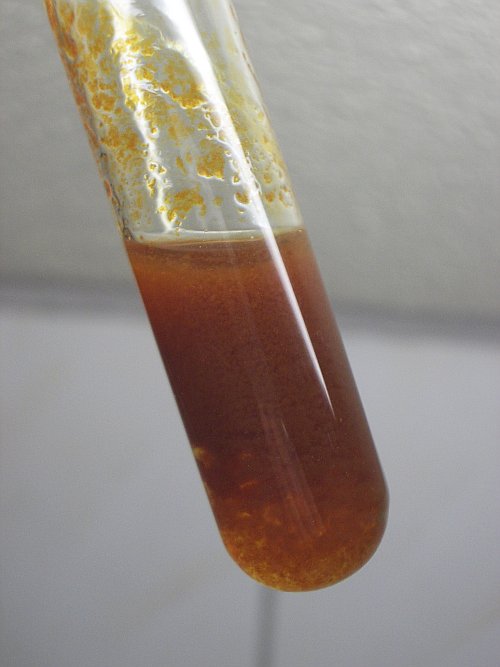
![]()
Oxidation state +4
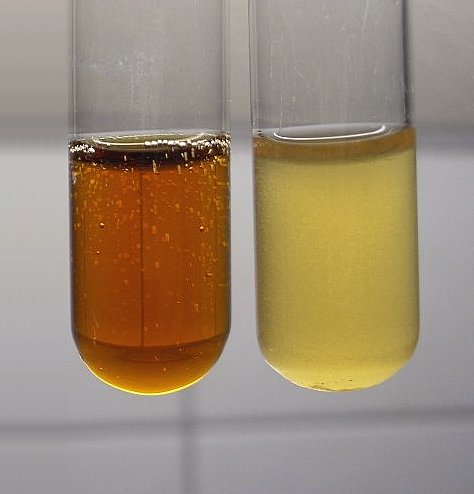 This oxidation state is
the least stable and not well-known. It is prepared by adding hydrogen peroxide
to a solution of an iron (II) salt. What precisely happens in such a solution is
still a topic of research, but a very plausible mechanism appears to be the
following:
This oxidation state is
the least stable and not well-known. It is prepared by adding hydrogen peroxide
to a solution of an iron (II) salt. What precisely happens in such a solution is
still a topic of research, but a very plausible mechanism appears to be the
following:
Iron (II) ions, with 6 water molecules as ligand are attacked by the hydrogen peroxide. One water ligand is replaced by a hydrogen peroxide ligand. Due to charge shifting, the hydrogen peroxide ligand breaks apart in a hydroxyl ligand and a free hydroxyl radical. The hydroxyl ligand in the coordination sphere of the iron (II) core is converted to hydroxide, the iron core being oxidized to the +3 oxidation state. The other hydroxyl radical, which is free picks a hydrogen atom from one of the water ligands of the iron (III) hydroxo complex. Now, again the iron has a hydroxyl ligand, which oxidizes the iron core to the +4 oxidation state, itself being converted to a hydroxide ligand. The final result of this is formation of [Fe(H2O)4(OH)2]2+. Some researchers think that the two hydroxide ligands rearrange and that a so-called ferryl ion is formed: [FeO(H2O)5]2+.
The picture shows a solution, containing the iron (IV) species in the left test tube and for comparison purposes a solution of an iron (III) salt of similar concentration is shown. This solution is is turbid, due to hydrolysis, as described in the section for oxidation state +3. The iron (IV) species is not stable. It looses oxygen, which escapes from the liquid as bubbles and after a while, the solution becomes turbid and rusty brown, due to formation of hydrous ferric hydroxide.
![]()
Oxidation state +6
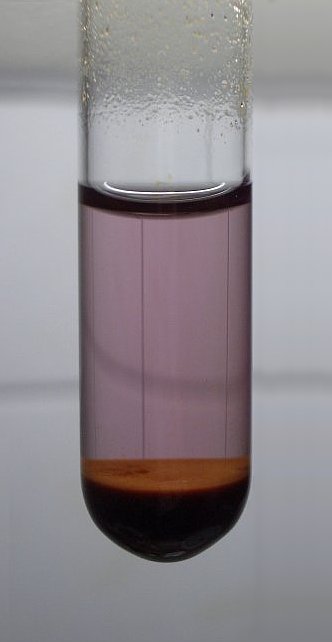 This oxidation state
also is not well-known. High-school chemistry certainly does not
mention this oxidation state of iron. Iron in the +6 oxidation state can be
prepared in strongly alkaline and strongly oxidizing media at elevated
temperatures.
This oxidation state
also is not well-known. High-school chemistry certainly does not
mention this oxidation state of iron. Iron in the +6 oxidation state can be
prepared in strongly alkaline and strongly oxidizing media at elevated
temperatures.
The picture at the left shows a solution, containing ferrate (VI) ions, FeO42-(aq). This was prepared by heating a precipitate of hydrous ferric hydroxide (as shown above for iron in the +3 oxidation state) with some bleach. The result is a solution, containing ferrate (VI) ions, above a precipitate of hydrous ferric hydroxide.
back to solutions/precipitates main page
back to miscellaneous main page